by Elizabeth Doerr and Dr. Magnus Bosse
Paul Gerber is a soft-spoken master of miniaturization, who has been constructing complications in his Zurich basement workshop since 1976. But he did not become well known to watch aficionados until the legendary Caliber 92 super complication landed in Gerber’s atelier with instructions from the new owner to add a few more.
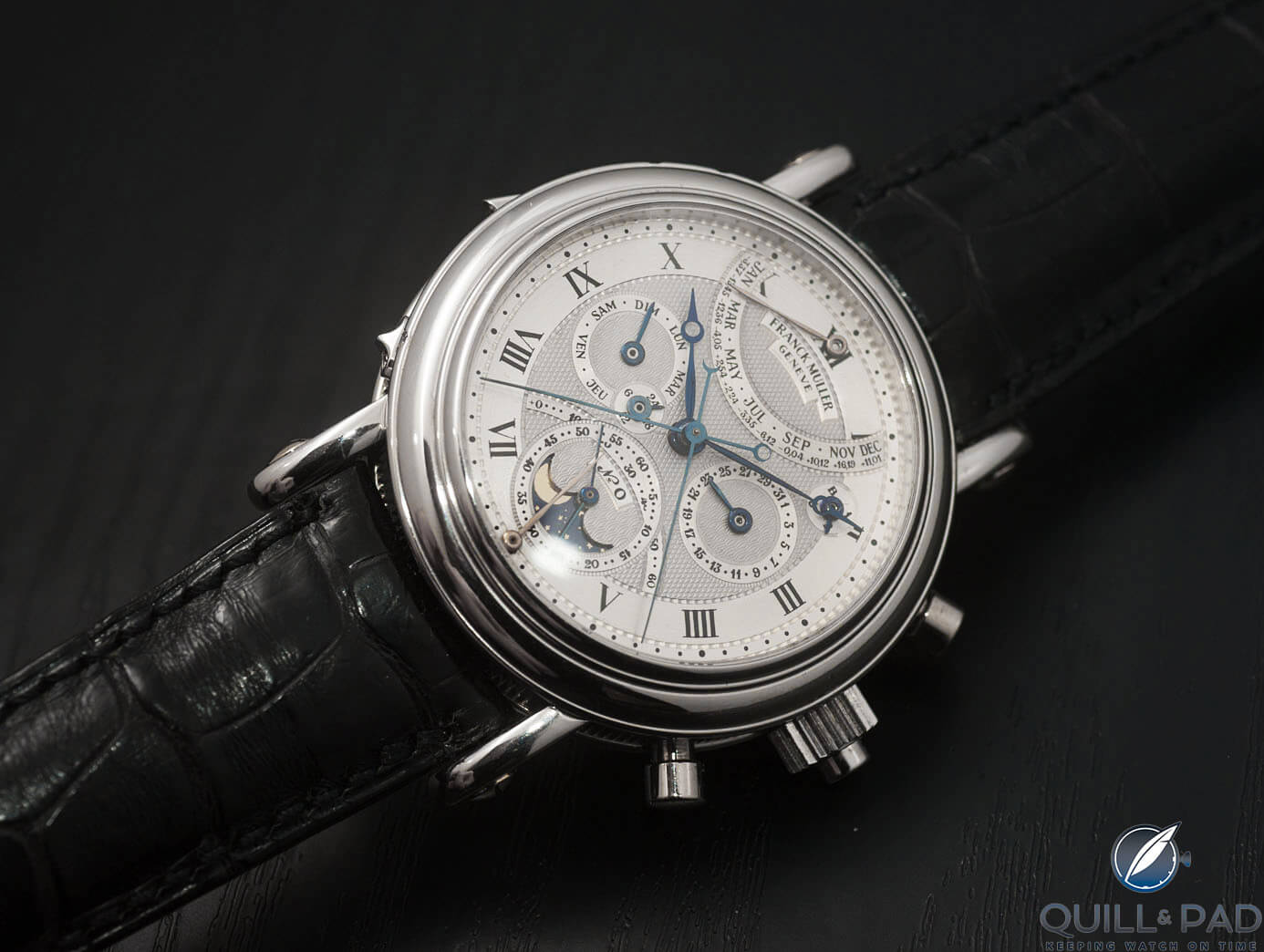
The Superbia Humanitatis watch created by Louis-Elysée Piguet, Franck Muller, and Paul Gerber (photo courtesy Dr. Magnus Bosse)
Caliber 92 was named as such by Franck Muller in 1992 after he had added more complications to an already complicated Louis-Elysée Piguet movement, then making it the world’s most complicated wristwatch.
This is one watch with a history, and as Gerber put it: “I really think that this is one of the most legendary watches of our time.”
Louis-Elysée Piguet, who founded his company in 1858 and whose descendants would continue in the industry today with Frédéric Piguet S.A. (not related to Audemars Piguet, but rather the workshop that would become Blancpain’s movement maker), created three very ornate pocket watches for women in 1892, two of which have been lost over time.
The third possessed a petite movement 32 millimeters in diameter and 8 millimeters in height that was fairly complicated: subsidiary seconds, minute repeater, silence function, and a large and small sonnerie were all included.
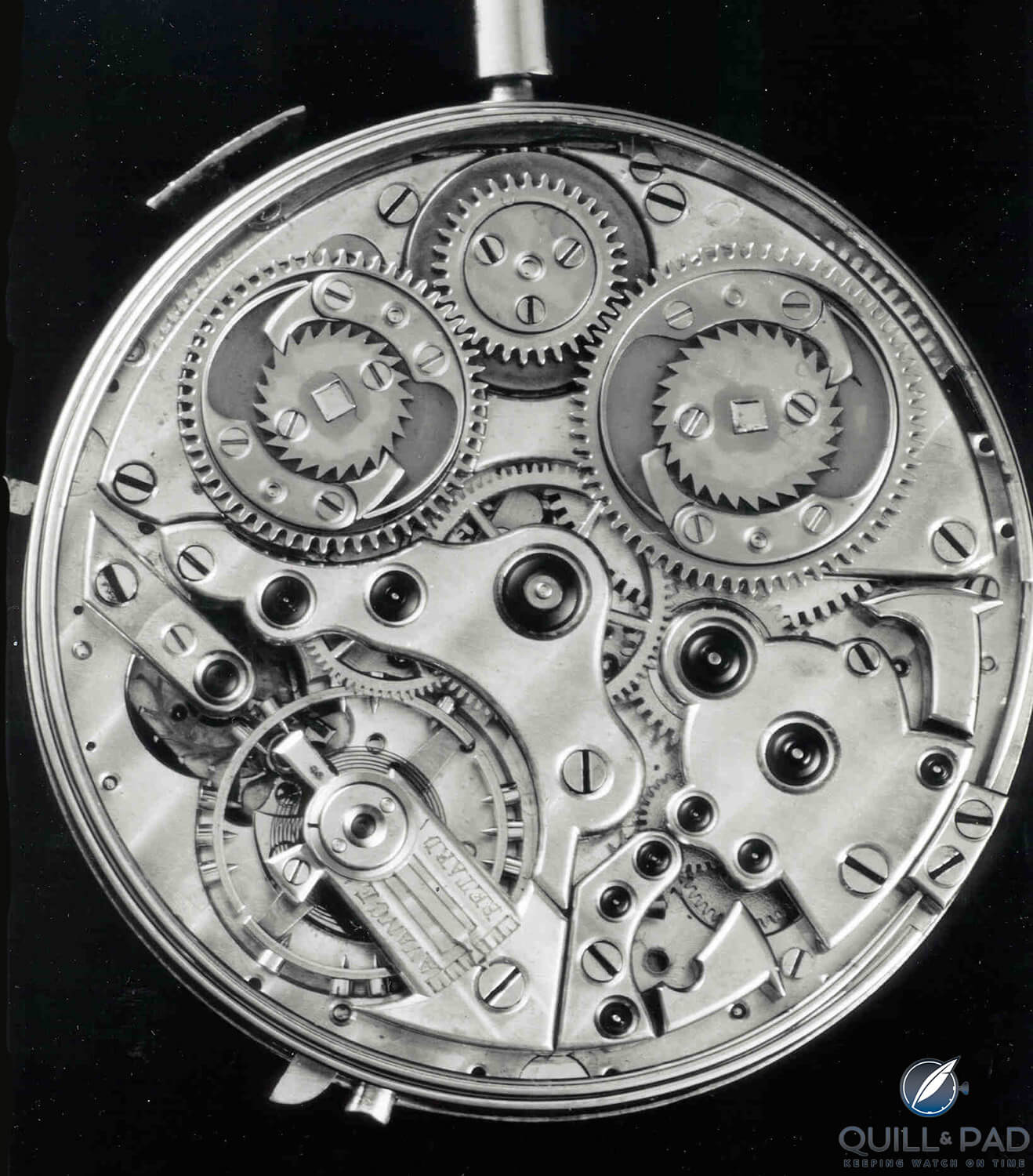
The grand sonnerie minute repeating movement created in the specialist ateliers of Louis-Elysée Piguet as it left Le Brassus in 1892
The 32-millimeter movement surfaced a century later in 1992 with the self-named “Master of Complications” and Gerber’s A.H.C.I. colleague, Franck Muller, who had given it the title “The Most Complicated Wristwatch in the World.” Muller showed it in Basel 1992 as that year’s edition of his annual specialty series – hence the moniker Caliber 92.
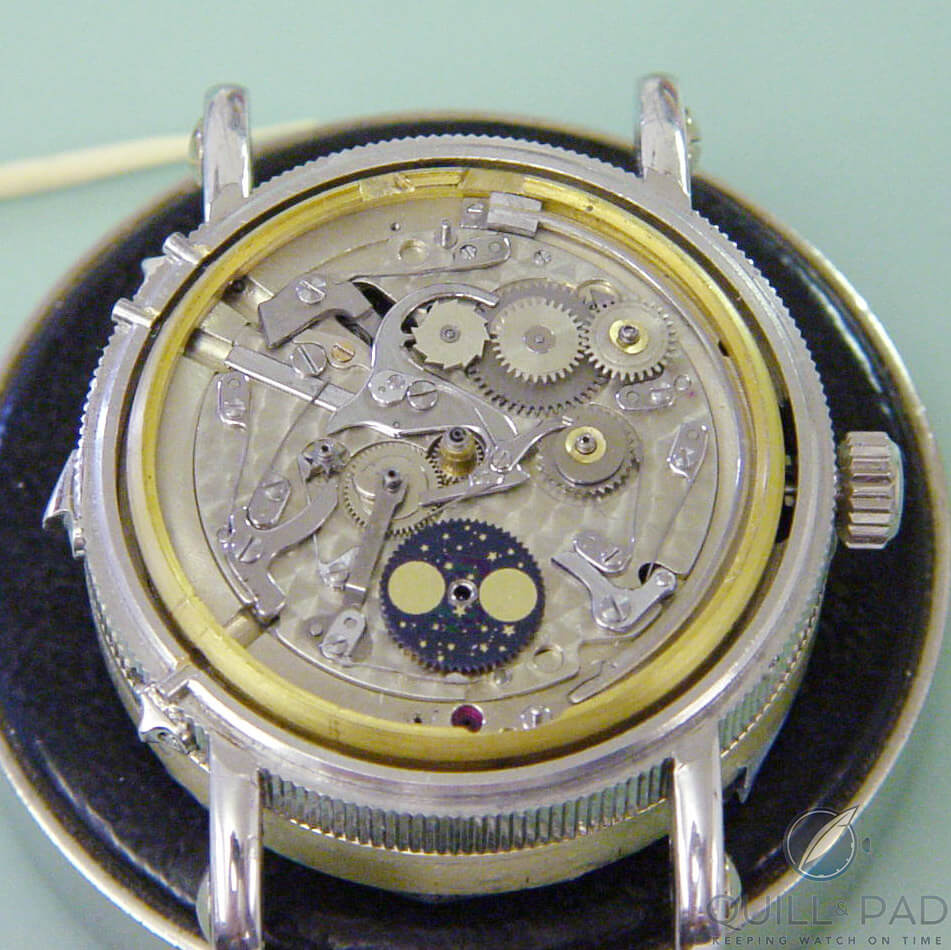
Perpetual calendar and thermometer module added by Franck Muller (photo courtesy Paul Gerber)
Aiming for a world record, Muller had modified the movement with more complications in the form of a perpetual calendar with moon phase, a 24-hour hand, and a thermometer displayed by a retrograde hand.
The module for the underdial work made the movement slightly higher, but the diameter remained the same. Muller then encased it in platinum and created a new, beautifully hand-guilloche dial.
How to add a flying tourbillon
Noted watch collector “Lord Arran” then bought the watch because he was intrigued by the idea of owning the most complicated wristwatch in the world and wondered if it could be made even more complicated. He had a few ideas and asked around, but nobody he talked to was prepared for such a challenge: this was the horological equivalent of touching up the Mona Lisa to make a great painting even greater. Muller had gotten away with it; another watchmaker potentially modifying this masterpiece might not be so lucky.
After all others had said no, he came upon Gerber, who always ready to take on a challenge and quickly accepted.
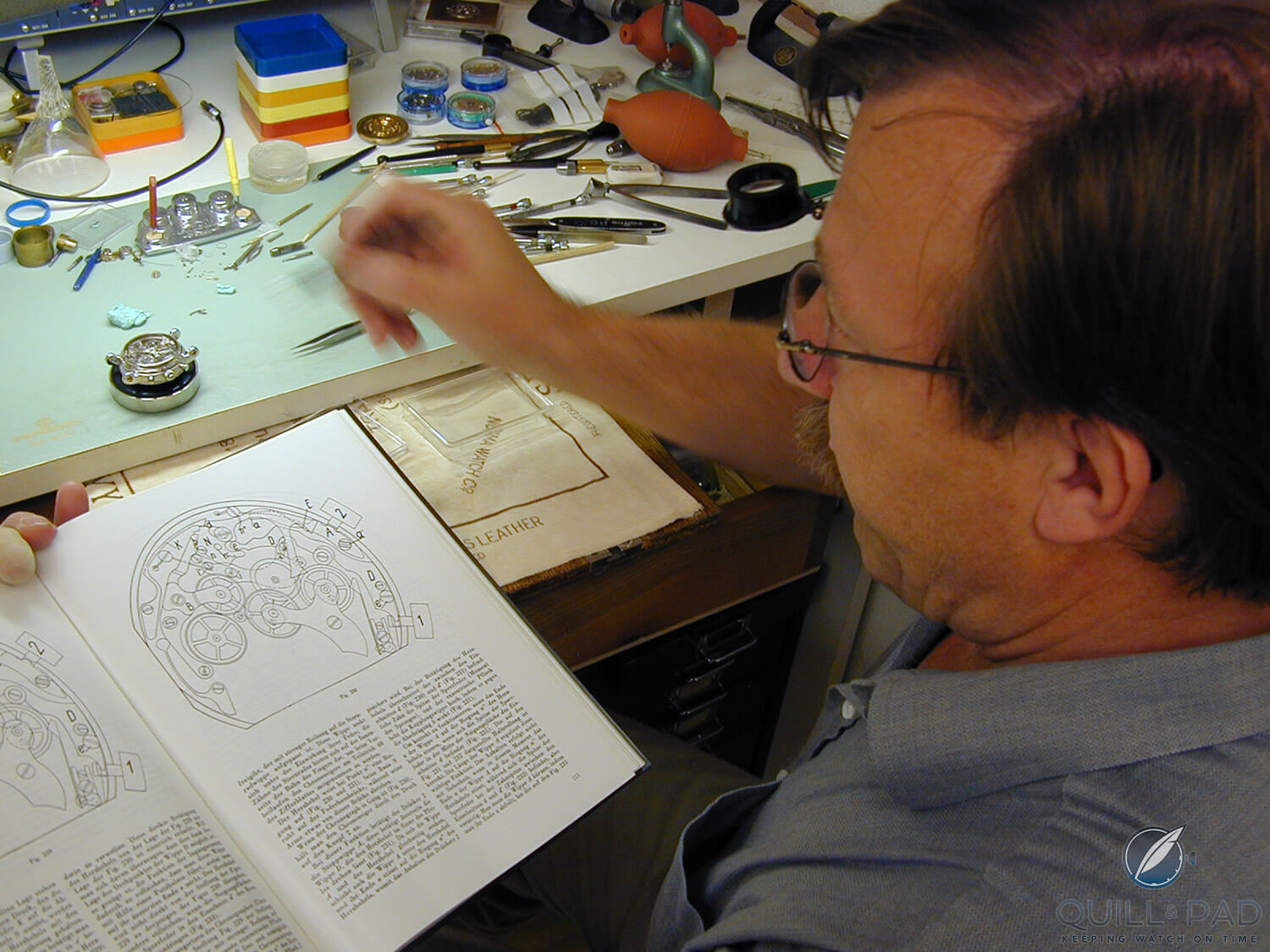
Paul Gerber was the expert watchmaker of choice to realize Lord Arran’s desired enhancements of Caliber 92 (photo courtesy Dr. Magnus Bosse)
Gerber is a master of miniaturization, but he literally had his work cut out for him as Lord Arran wanted a flying tourbillon. Gerber had never constructed a normal tourbillon before, let alone a flying tourbillon, so he naturally said yes. And if creating a flying tourbillon wasn’t enough of a challenge by itself, Lord Arran demanded that the original balance and balance spring of the more than 100-year-old base movement be integrated into the new escapement.
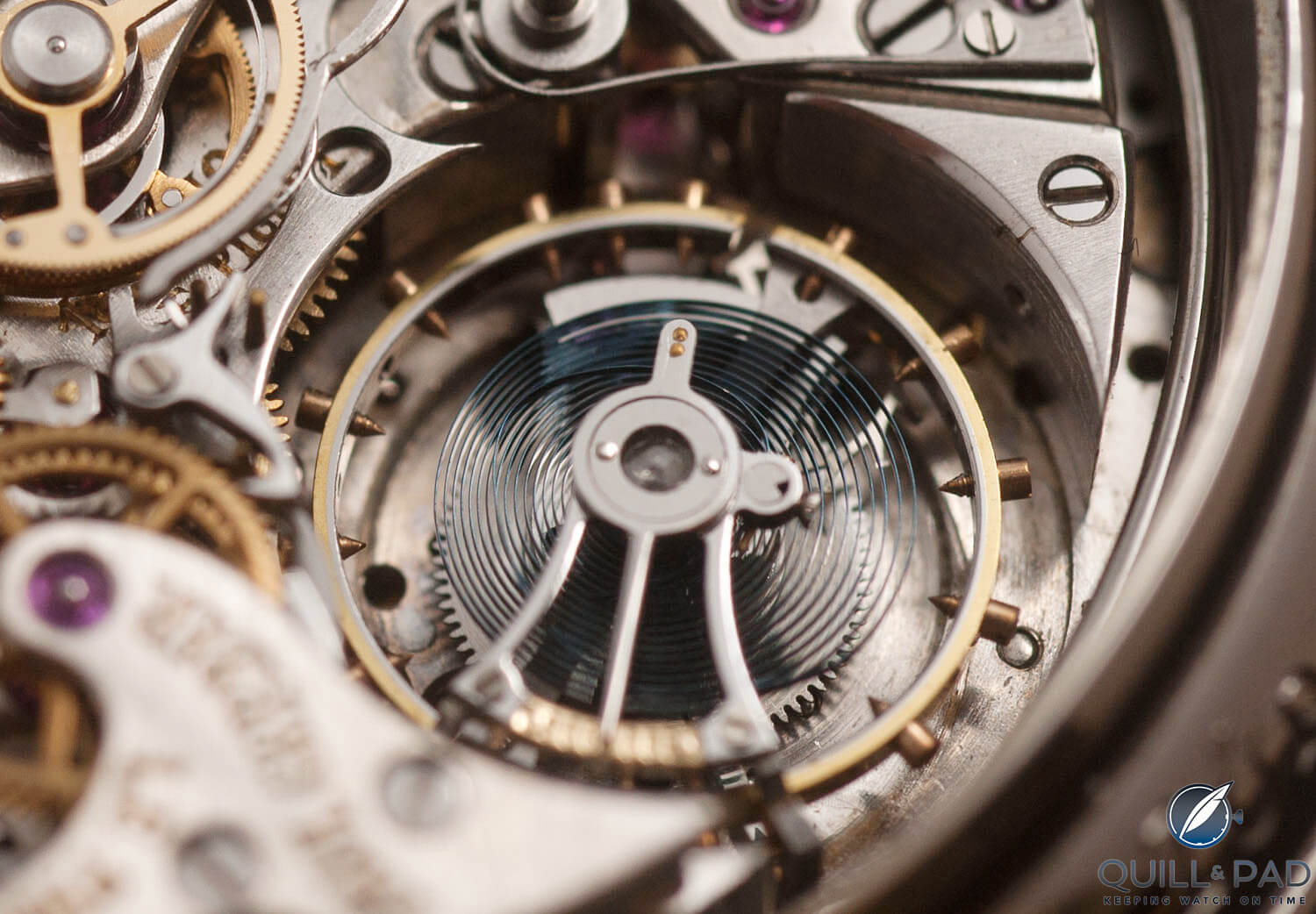
The Superbia Humanitatis’ flying tourbillon with the original balance and balance spring from 1892 (photo courtesy Dr. Magnus Bosse)
Because a flying tourbillon is cantilevered – meaning only attached to the plate on one side – it seems to be detached from the rest of the movement, so the view of the filigreed mechanism isn’t blocked by bridges or plates.
The most difficult aspect of this part of the project for Gerber was the fact that in order to add the tourbillon, the mainplate itself needed to be changed. “If I had made just one mistake while milling, the whole watch would have been irreversibly damaged,” Gerber said in regard to his incredible feat.
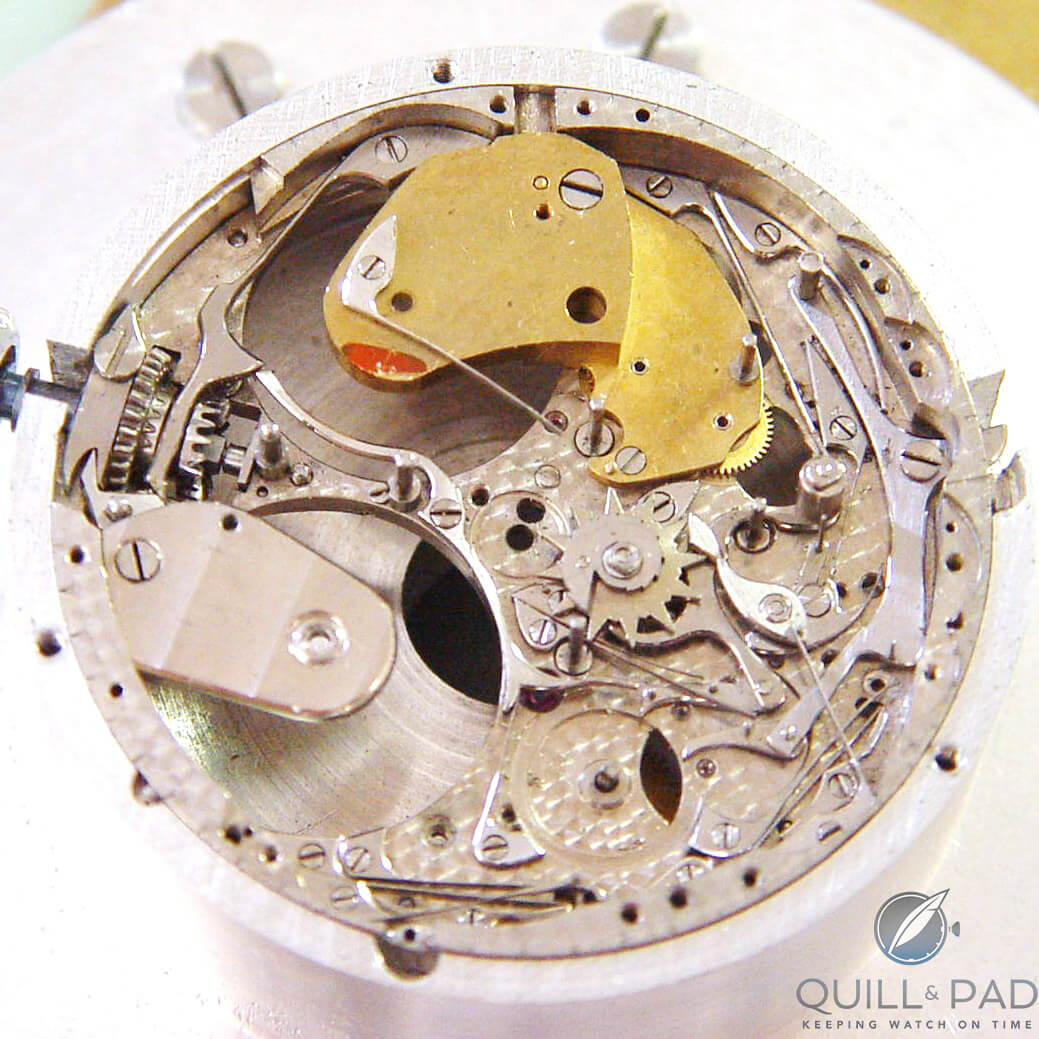
Adding the flying tourbillon required irreversible modifications to the base movement, which proved particularly tricky since it also has a chiming mechanism
Although Gerber designed and constructed the tourbillon and the altered plate on his computer, he was not taking any chances. He first built a larger dummy movement in order to “practice.”
When completed, Gerber exhibited what he called “Kaliber 17,” the world’s most complicated watch, at the A.H.C.I. booth at the 1995 Basel Fair. It was called “Caliber 17” because it is the seventeenth movement construction created by Gerber. Elsewhere it had become known as the “Piguet/Muller/Gerber Grand Complication” or even just “the Lord Arran.”
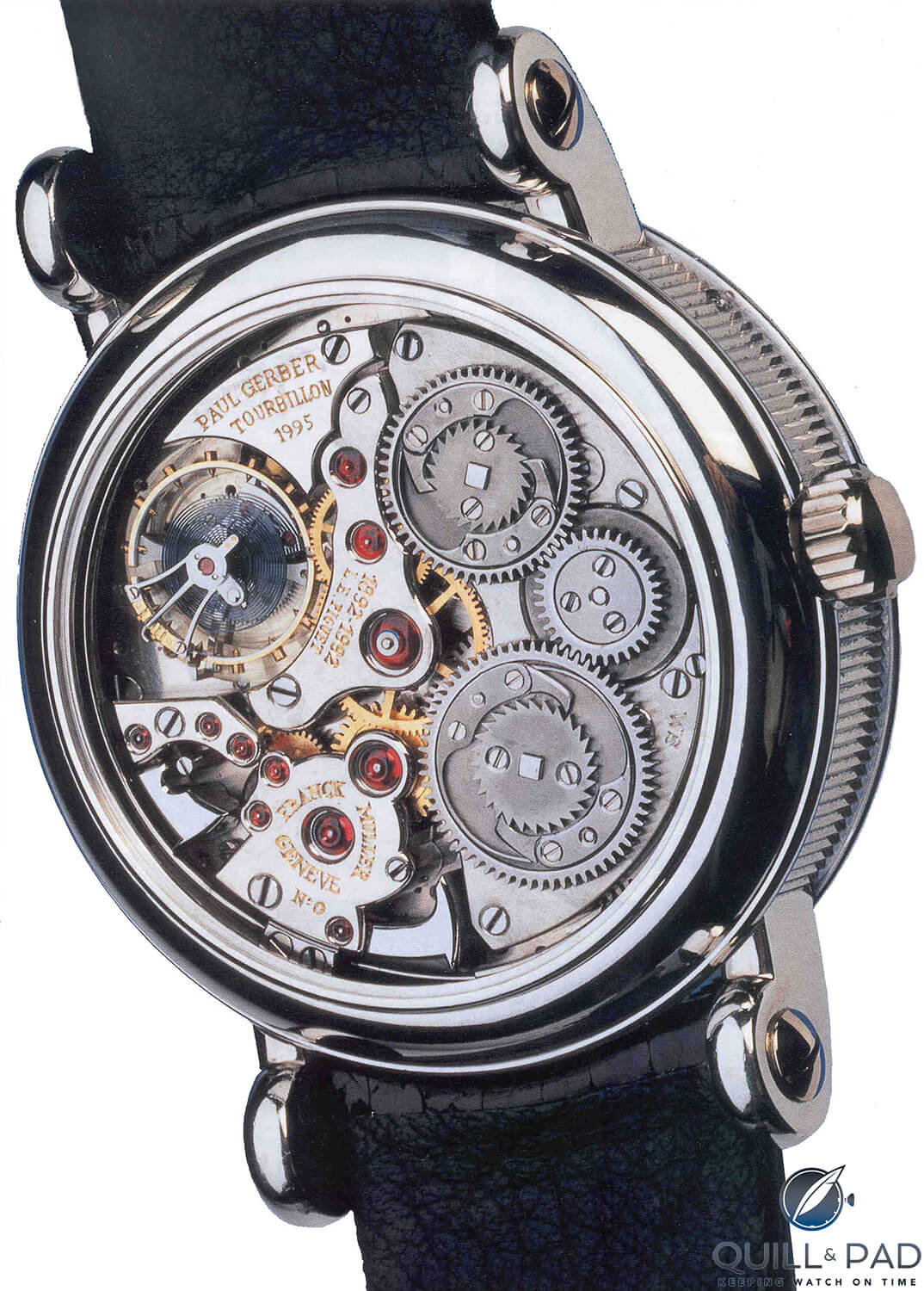
Caliber 17 as it was known in Paul Gerber’s workshop in 1995 after Gerber added the flying tourbillon
The story continues
The owner, while pleased with the flying tourbillon, wondered if even more complications were possible and returned the timepiece to Gerber. He specifically desired a split-second chronograph with flyback function. He also stipulated that many of the components, particularly the fine case and dial, were left untouched, which meant that making a module for a split-second chronograph was out of the question as it would have added more height to the movement.
Gerber would have to design a split-second chronograph with flyback function that fit inside rather than above the already jam-packed movement, which was another challenge he happily accepted.
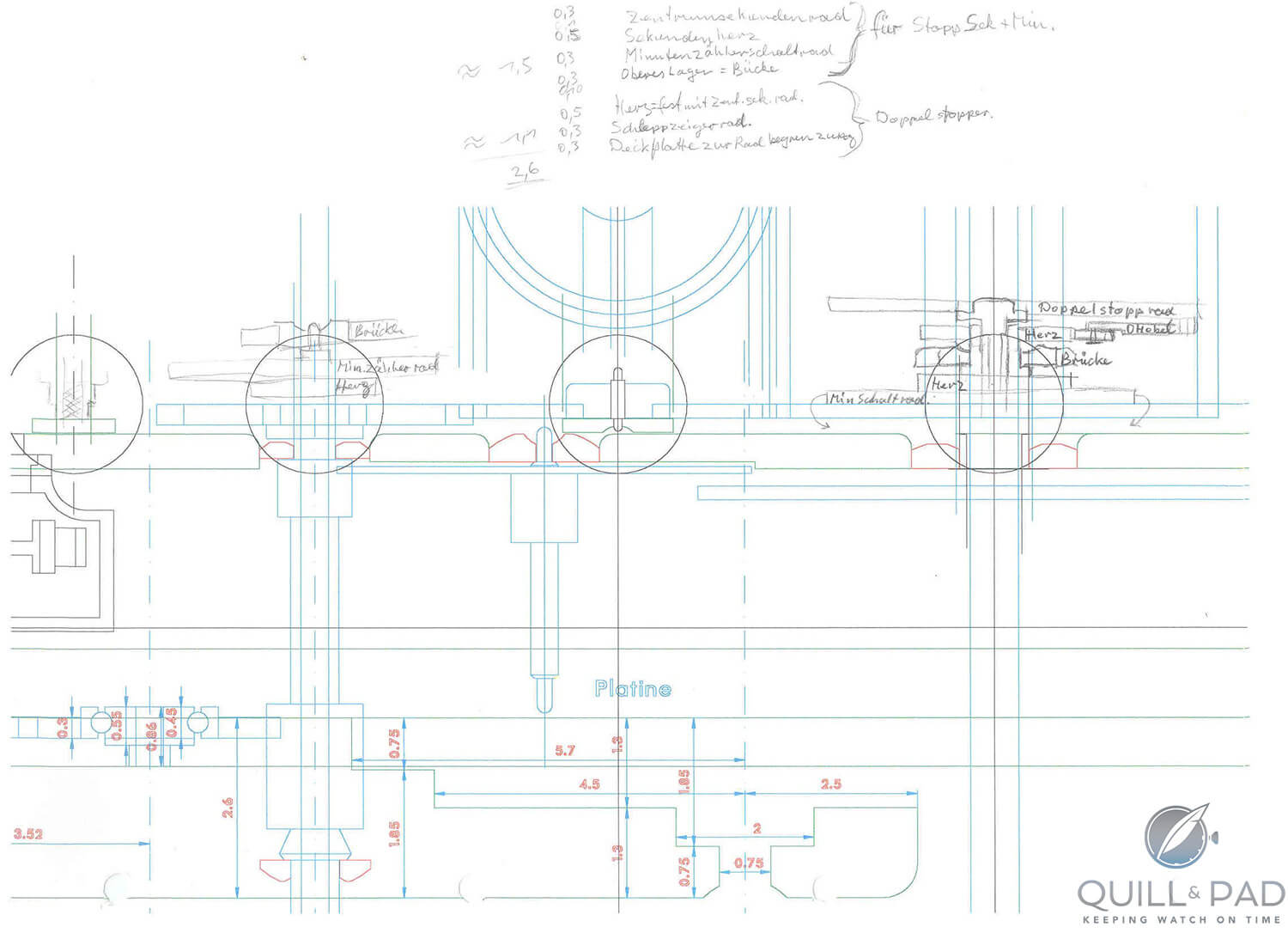
Paul Gerber had to carefully plan the chronograph design of Caliber 17 so that it would fit into the case and the dial layout
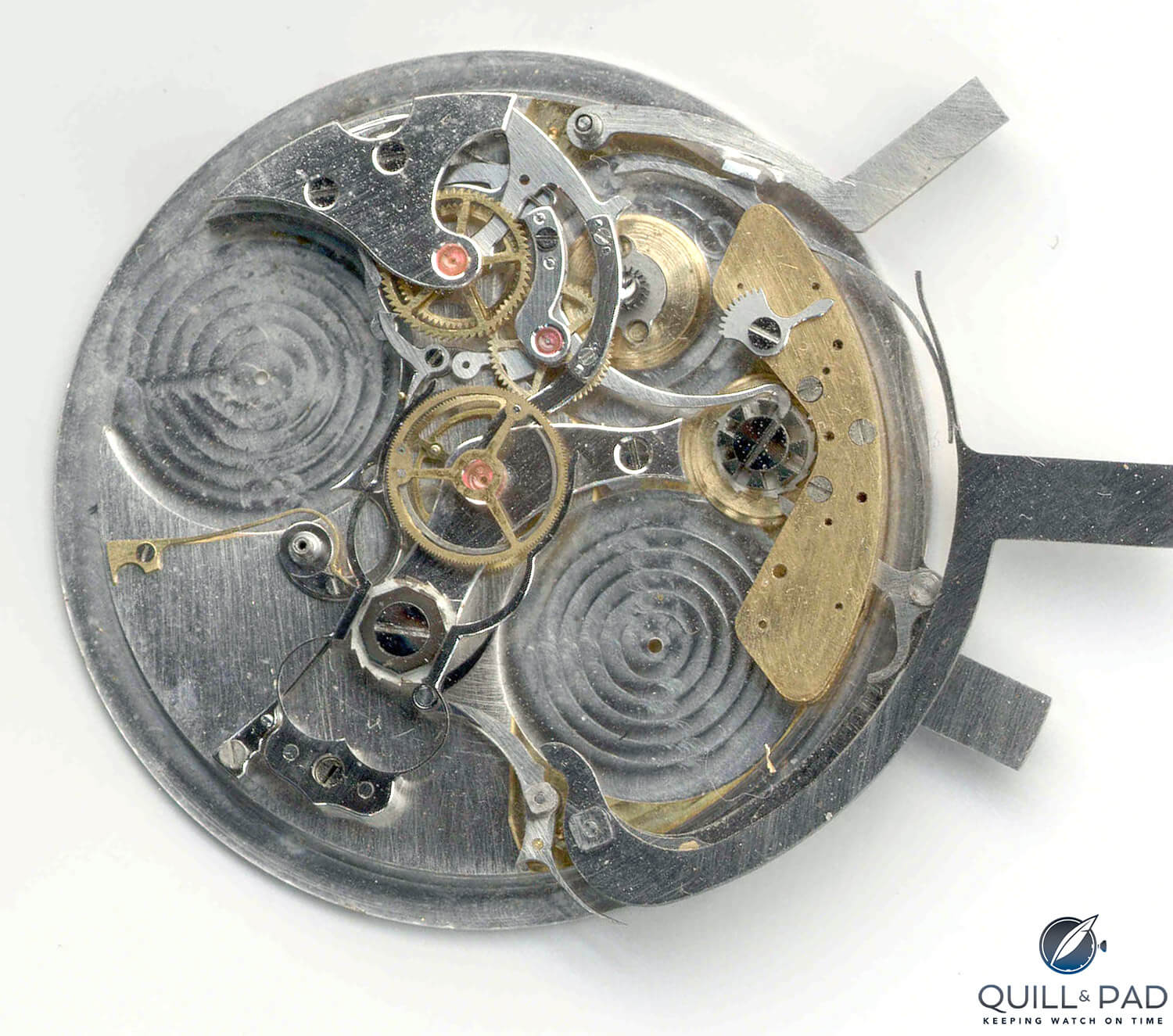
Paul Gerber created dummy plates to test that his design works properly before adding the chronograph to the irreplaceable Caliber 17
Every available millimeter of room was utilized so the chronograph and its special functions could be added to the back of the movement, thereby keeping everything visible. The twin barrels received power reserve indications, and the minutes became a jump minute counter, sharing space with the permanent second display, a highly unusual but necessary arrangement. The addition of a jumping minute counter actually came about due to the sheer lack of space for the more voluminous gears and wheels required for a normal minute counter.
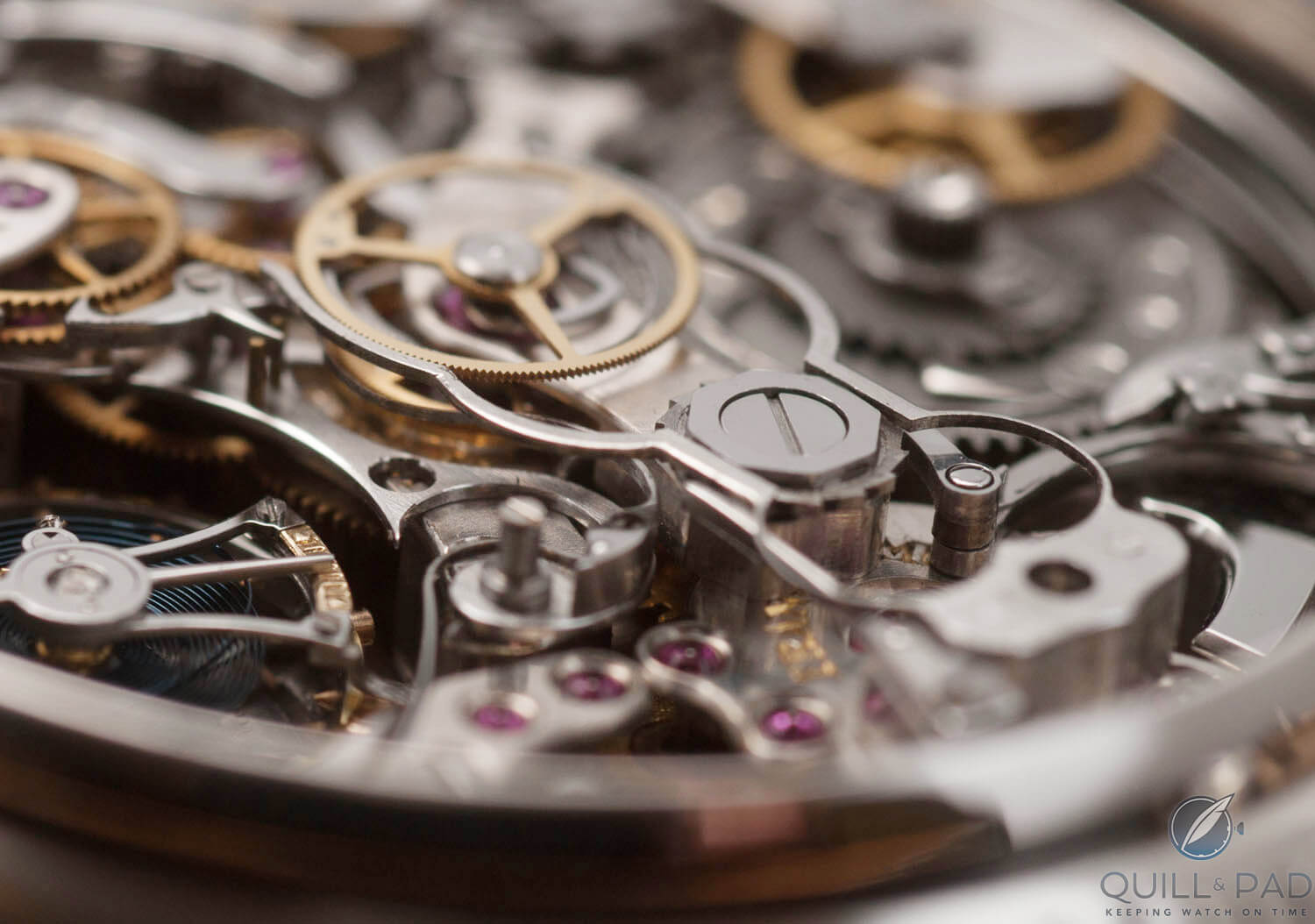
Detail view of the split-seconds mechanism; note how flat the column wheel is, a necessity in order to fit the parts into the existing case (photo courtesy Dr. Magnus Bosse)
The movement grew 2.6 millimeters higher due to an extra bridge for the two additional sweep hands, giving Gerber the opportunity to add a sapphire crystal case back and immortalizing the engraved signatures of all three watchmakers Louis-Elysée Piguet, Franck Muller, and Paul Gerber (as requested by the watch’s owner) and solving the height problem at the same time.
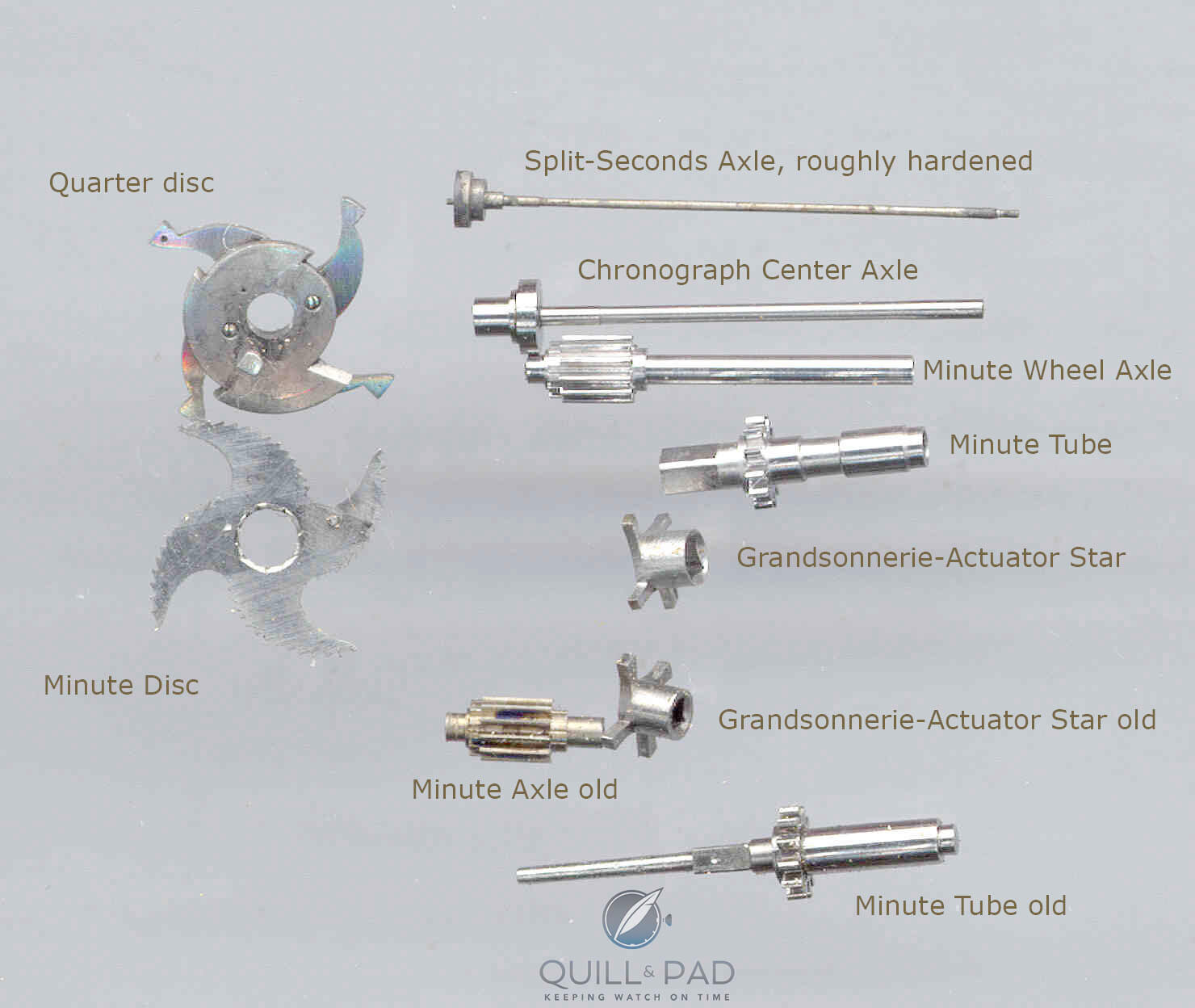
A number of parts needed to be produced from scratch and/or modified as a rattrapante mechanism was integrated into a movement not designed for this, which required subsequent modifications to the sonnerie as well
The dial Franck Muller had originally made for the timepiece remains the watch’s “face,” with Gerber designing the chronograph complication so that the indications of the existing dial could be used, but also serving double duty: the permanent seconds and the chronograph’s minute counter share a single subdial.
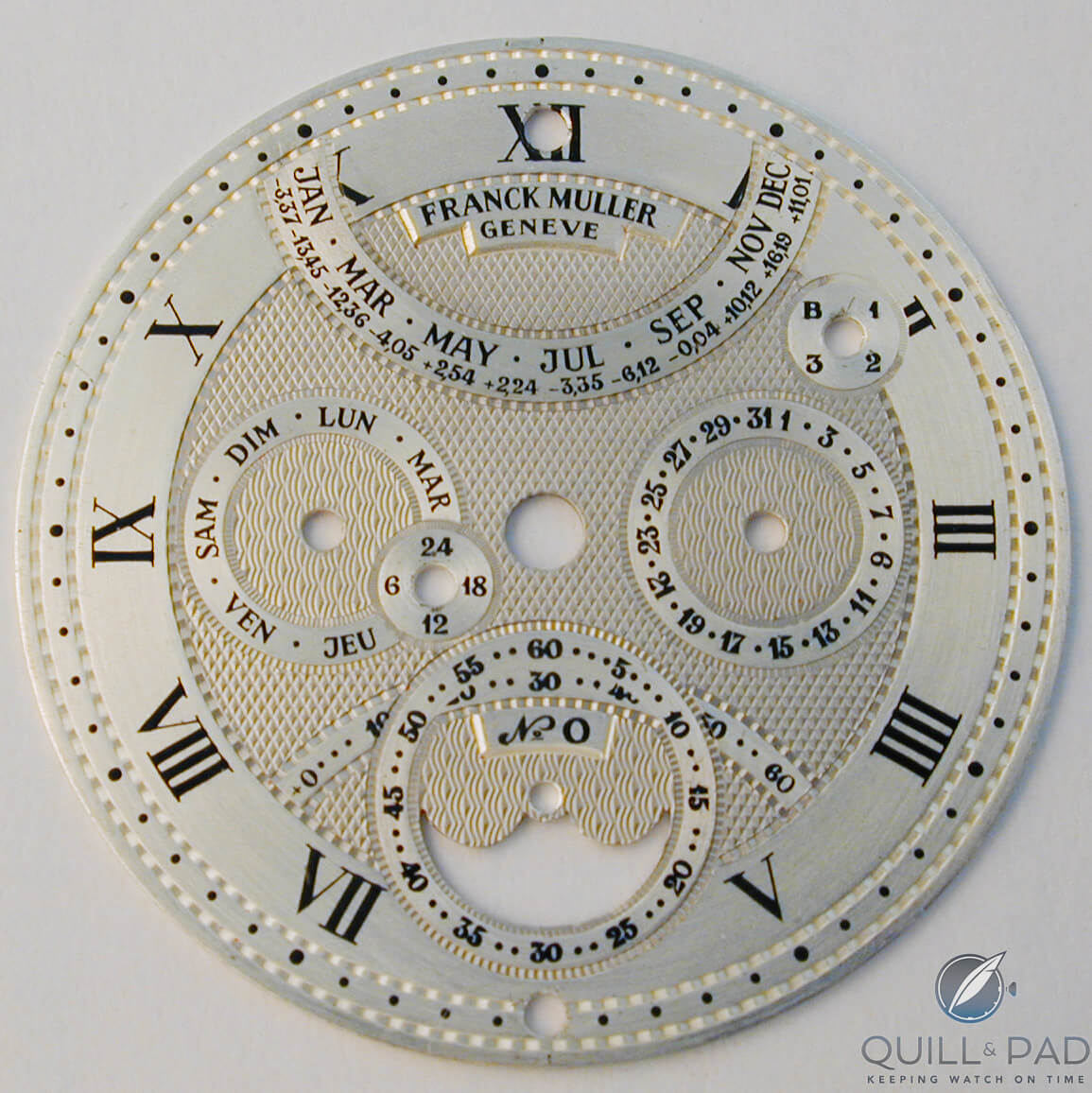
The magnificent dial of the Superbia Humanitatis (photo courtesy Dr. Magnus Bosse)
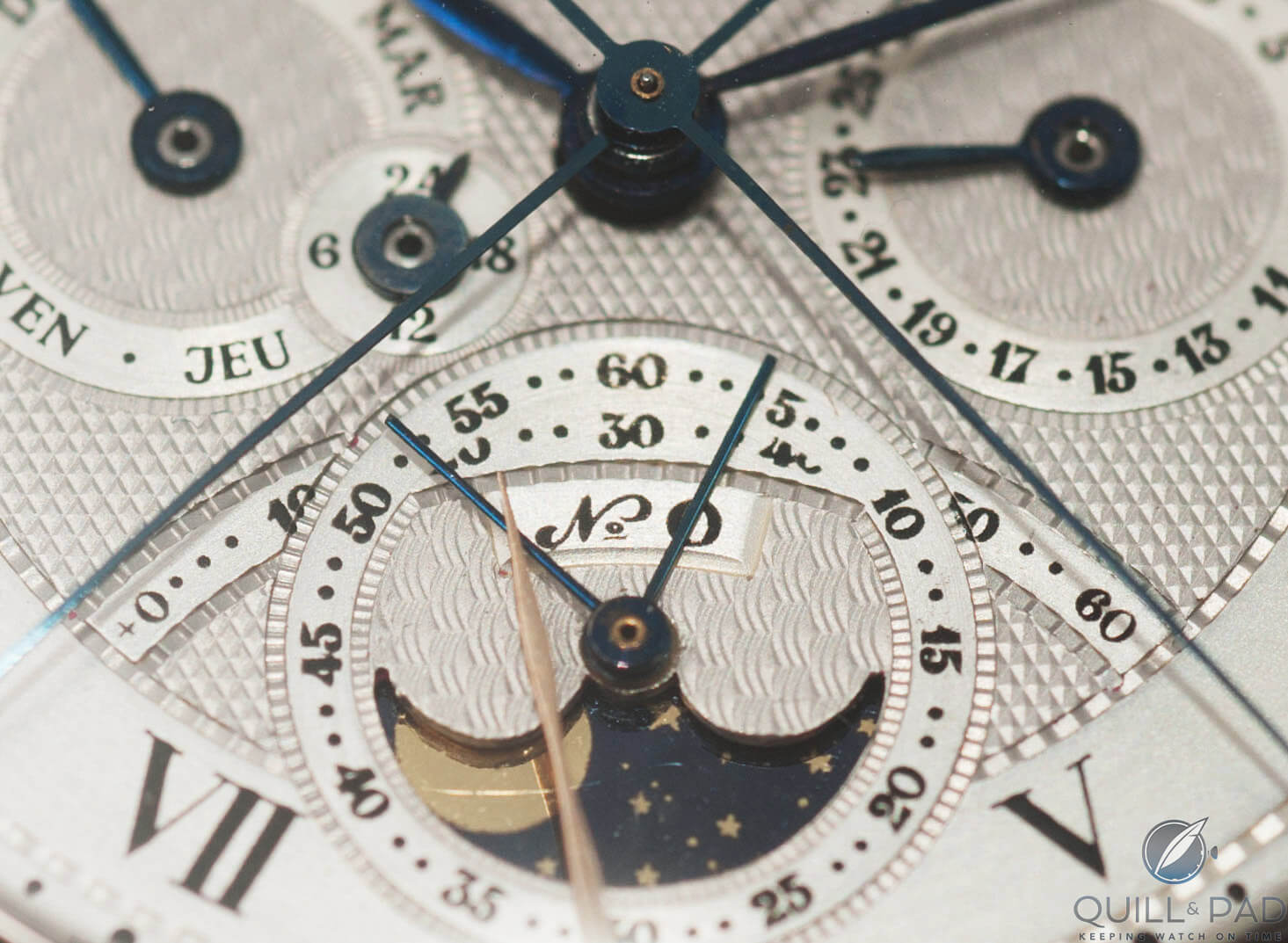
The seconds subdial of the Superbia Humanitatis doubles as the chronograph’s minute counter (photo courtesy Dr. Magnus Bosse)
Lord Arran’s watch returns to Gerber. Again
Lord Arran, however, was still not yet ready to call his Louis-Elysée Piguet, Franck Muller, and Paul Gerber watch completed: he took it back to Gerber once again to have the tourbillon’s ruby endstone replaced by a diamond in the tradition of the best haute horlogerie.
The tourbillon had to be modified as the ruby and its diamond replacement had different diameters.
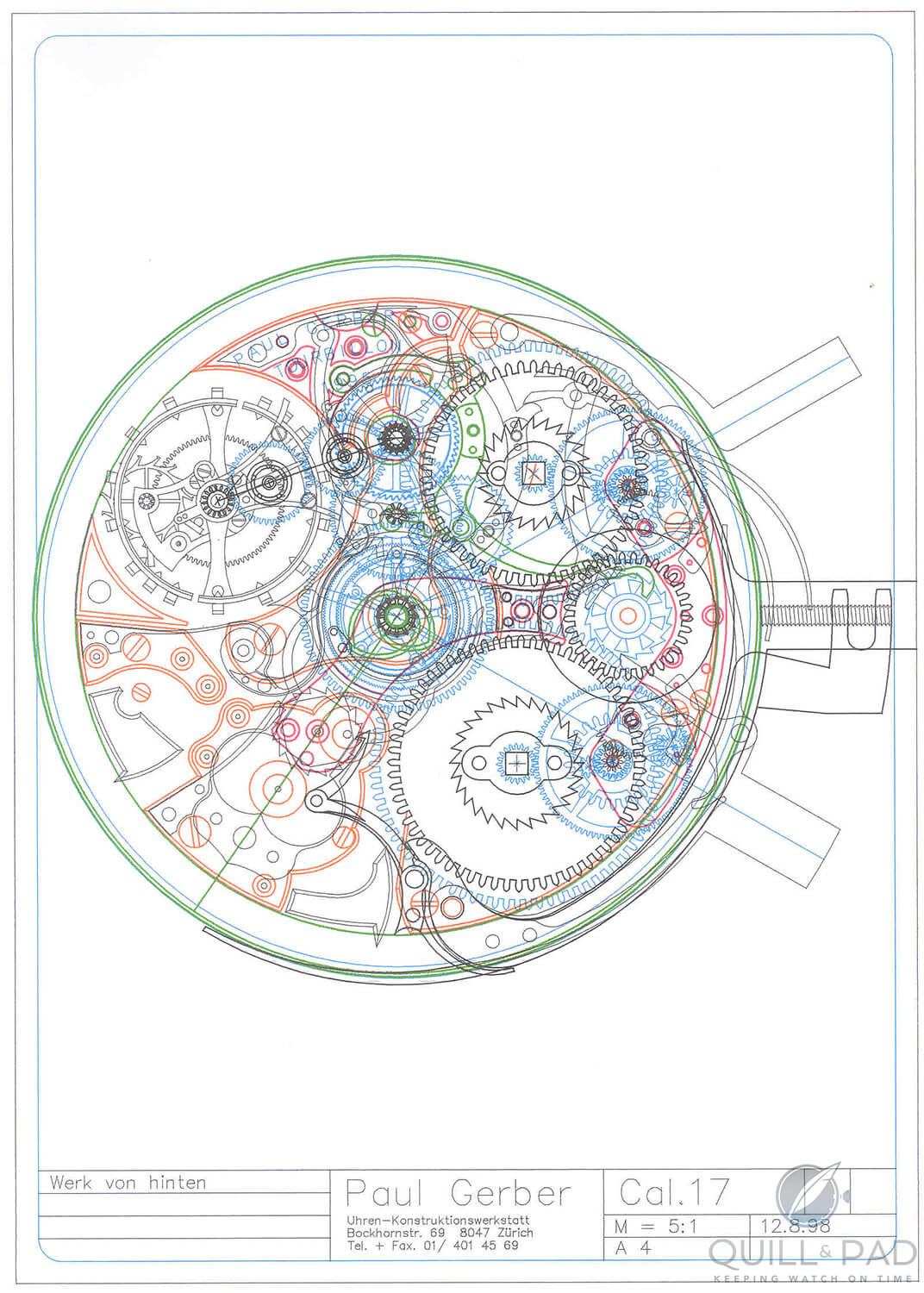
Technical drawing of the Superbia Humanitatis: any questions?
Finally, after more than a decade of outstanding watchmaking, Gerber had created a timepiece without precedence: 12 complications compressed into a surprisingly compact case, realized with a total of 1,116 parts.
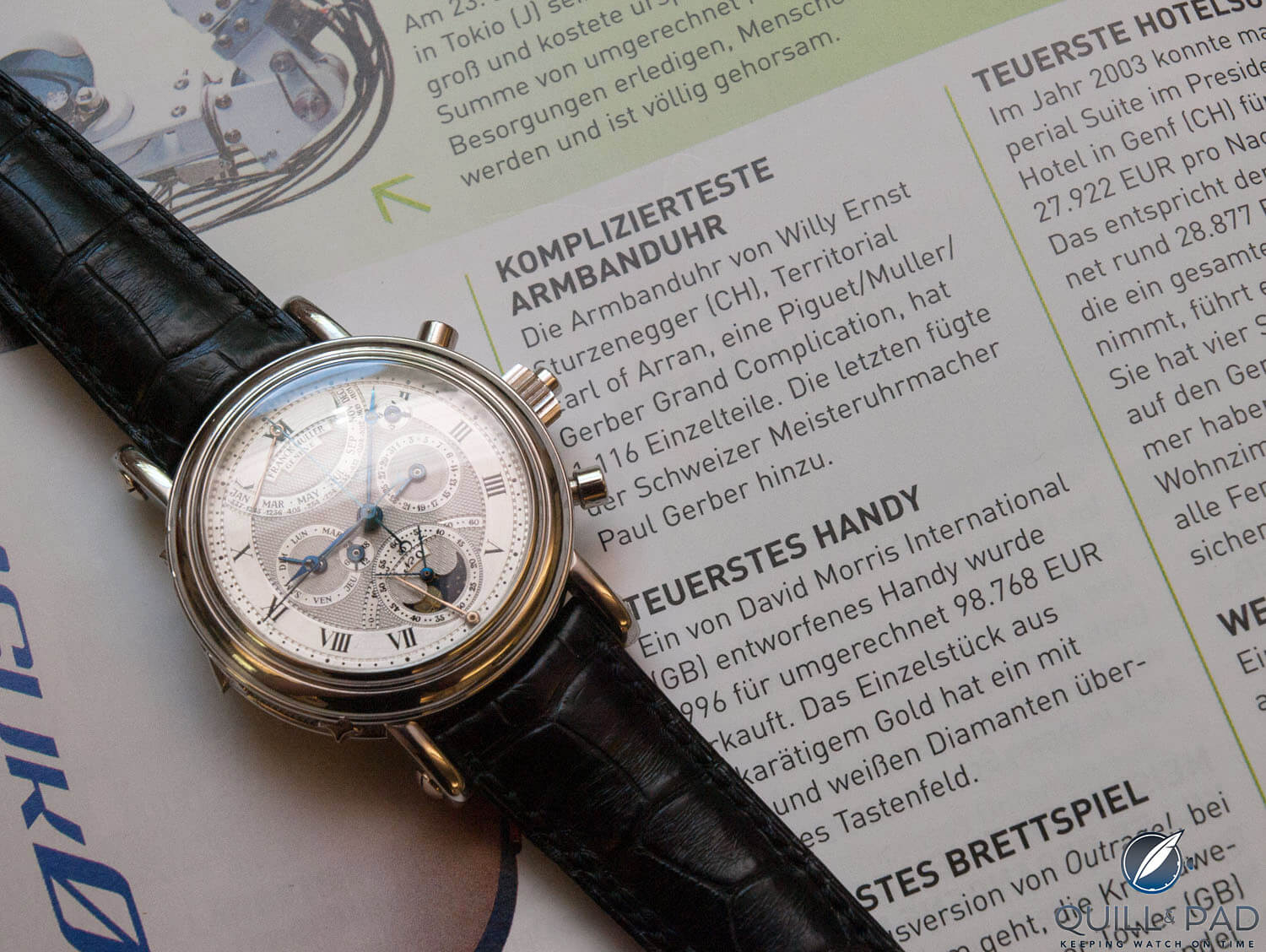
Since 2005 listed as the most complicated wristwatch in the world (by count of components): the Superbia Humanitatis
This was third time that the watch had been certified as having the world record for the most complicated wristwatch in the world (by count of components).
“In terms of the number of individual parts, the world’s most complicated wristwatch is the Piguet/Muller/Gerber Grand Complication watch, which contains 1,116 parts. It was most recently added to by master watchmaker Paul Gerber (Switzerland) and is owned by Willy Ernst Sturzenegger, Territorial Earl of Arran (Switzerland).”
To date, this recognition has not been successfully challenged, and no other complicated wristwatch has seen a mention in this category of the Guinness Book of World Records.
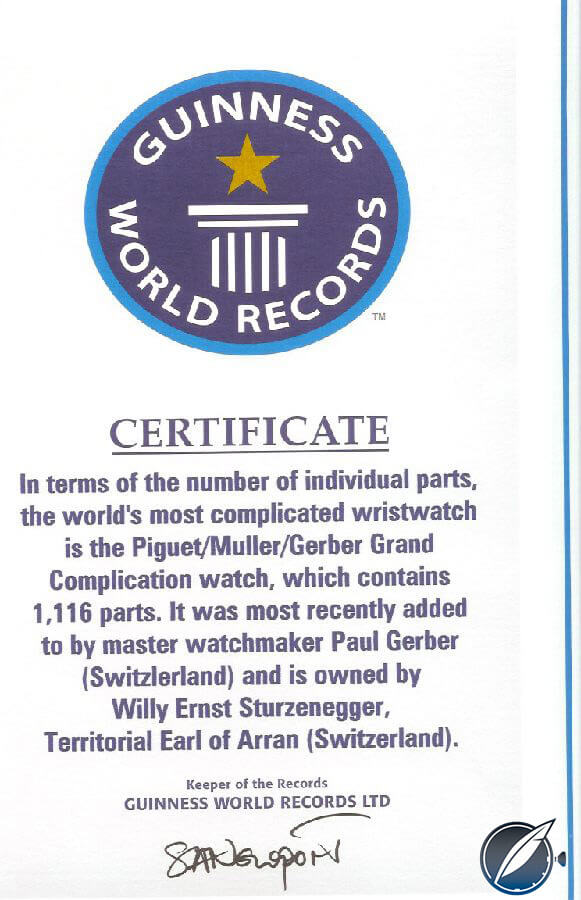
The certificate issued by the ‘Guinness Book of World Records’ to Paul Gerber
End of the story?
When asked whether another complication might be added to the Piguet/Muller/Gerber Grand Complication, Gerber replied in his mild-mannered way, “Not at this time!”
The story continues
Ralph Graf from Switzerland bought the Piguet/Muller/Gerber Grand Complication from Lord Arran and thought two areas might be improved: the level of aesthetic finishing should be brought up to a consistently high level and the timepiece was lacking a real, appropriate name.
So Gerber disassembled the watch once more down to the last of its 1,116 parts to take stock of the appearance and finish of each individual component, discussing with Graf which part would be modified and to what degree of finish.
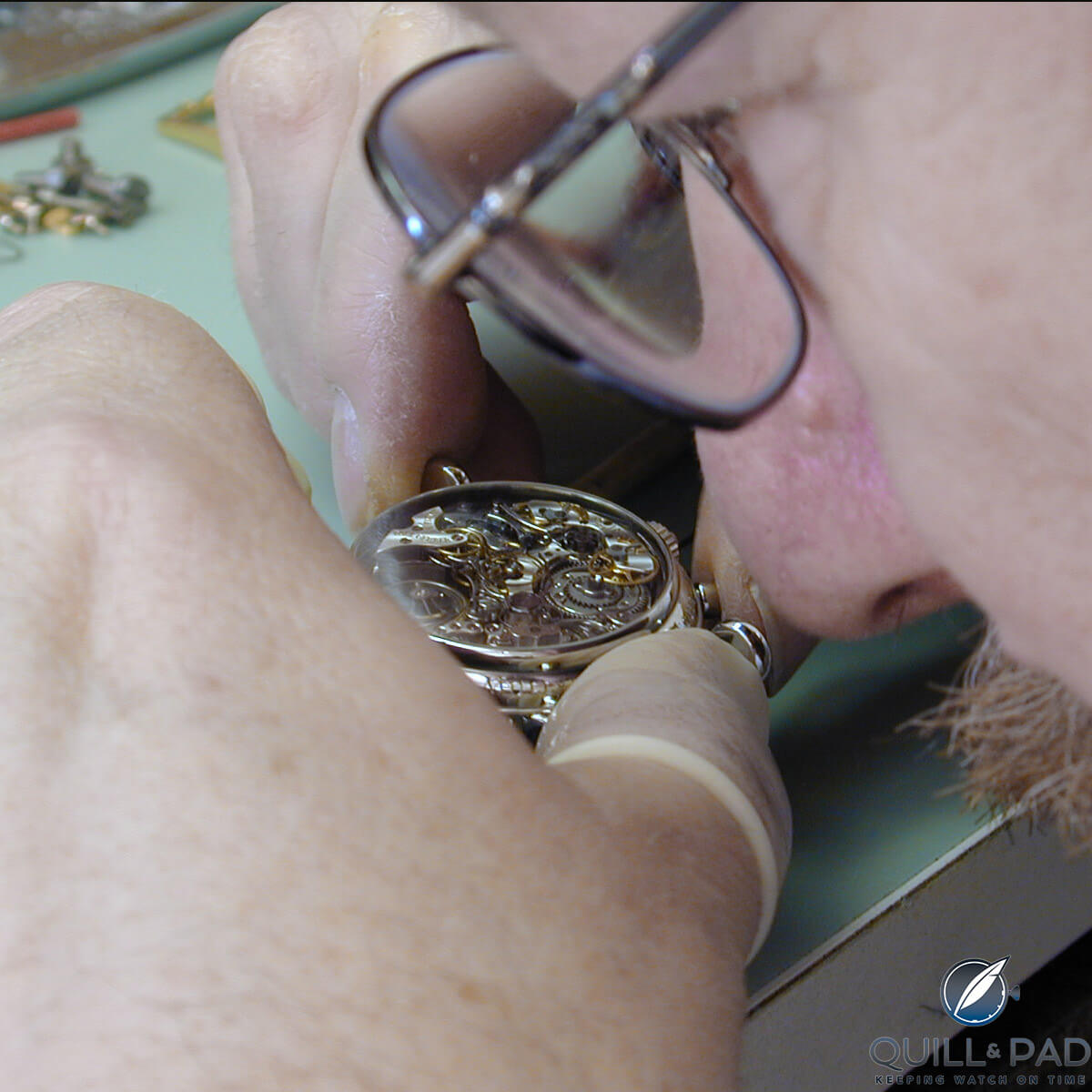
Paul Gerber inspecting the ultra-complicated movement of the Superbia Huminatitas (photo courtesy Dr. Magnus Bosse)
The overall goal was to achieve a homogeneous, subtle movement aesthetic appropriate for this outstanding technical timepiece, yet an aesthetic that would not overshadow or distract from the mechanics.
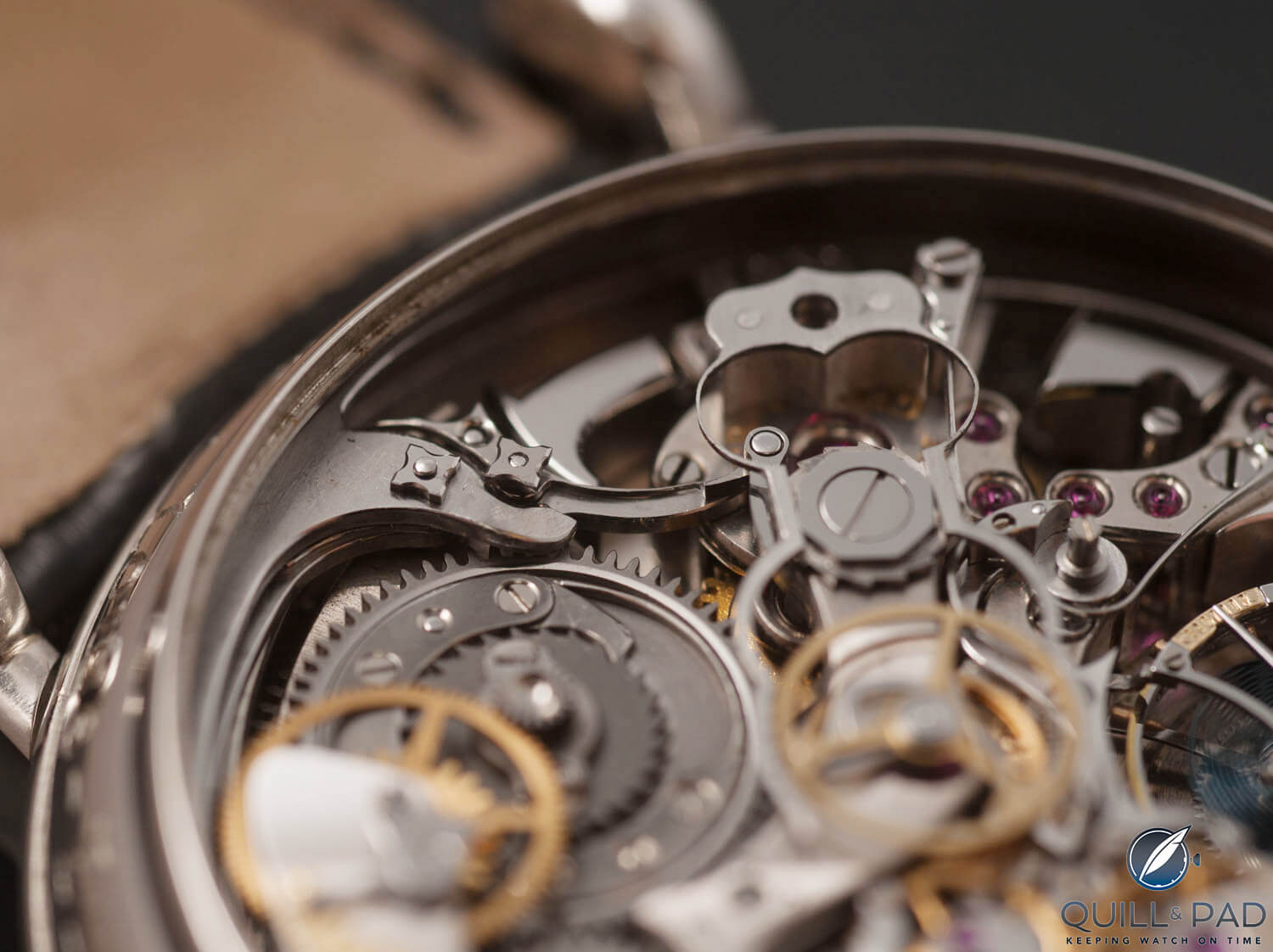
The two screws to the left, for example, were newly made by Gerber to increase visual appeal of the Superbia Huminatitis’ movement (photo courtesy Dr. Magnus Bosse)
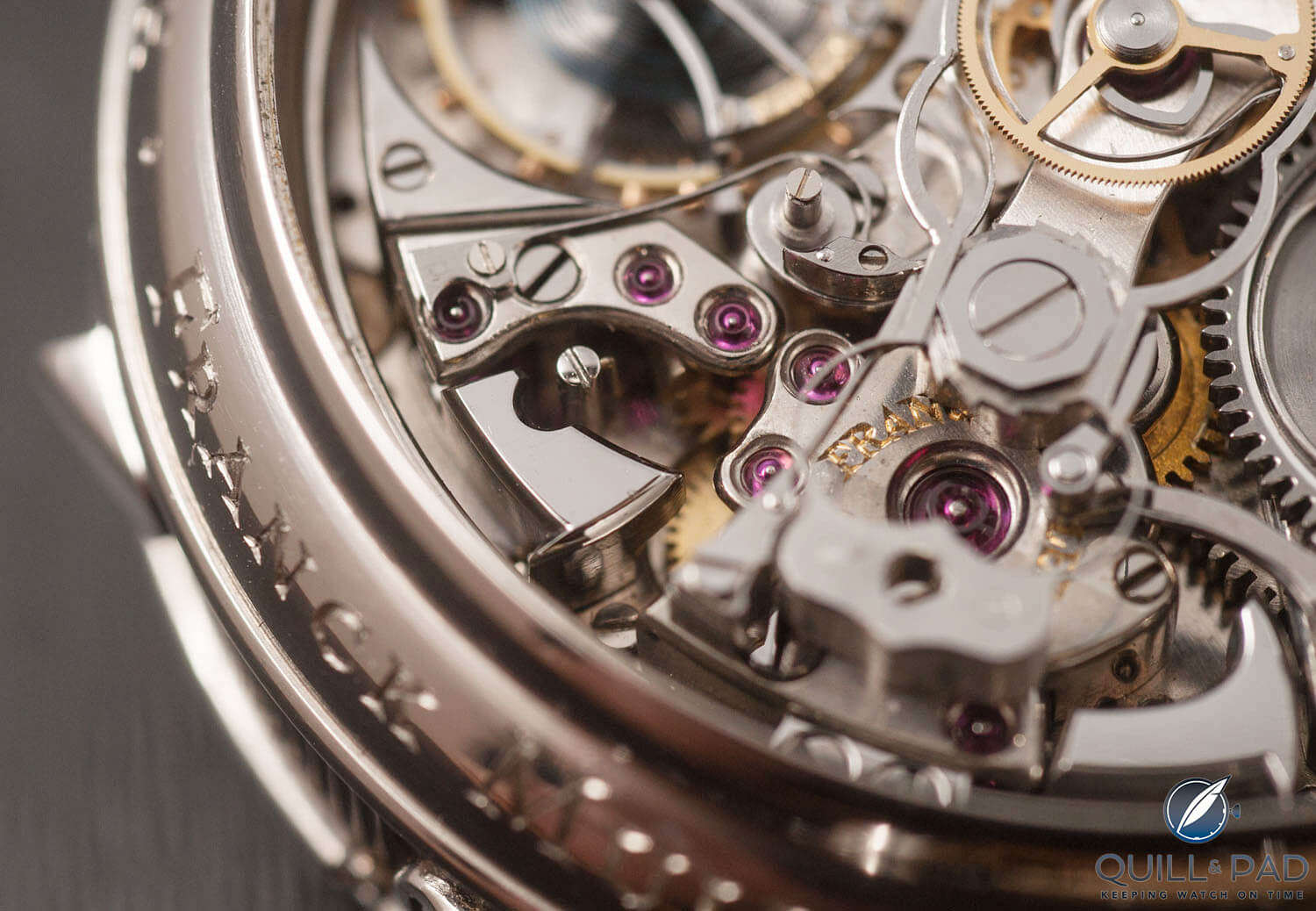
Centuries of watchmaking progress harmoniously united in one single piece (photo courtesy Dr. Magnus Bosse)
While the main task involved was to polish screws evenly and create consistent anglage, Gerber seized this opportunity to correct past missteps, such as the moon phase indication, which turned into the wrong direction.
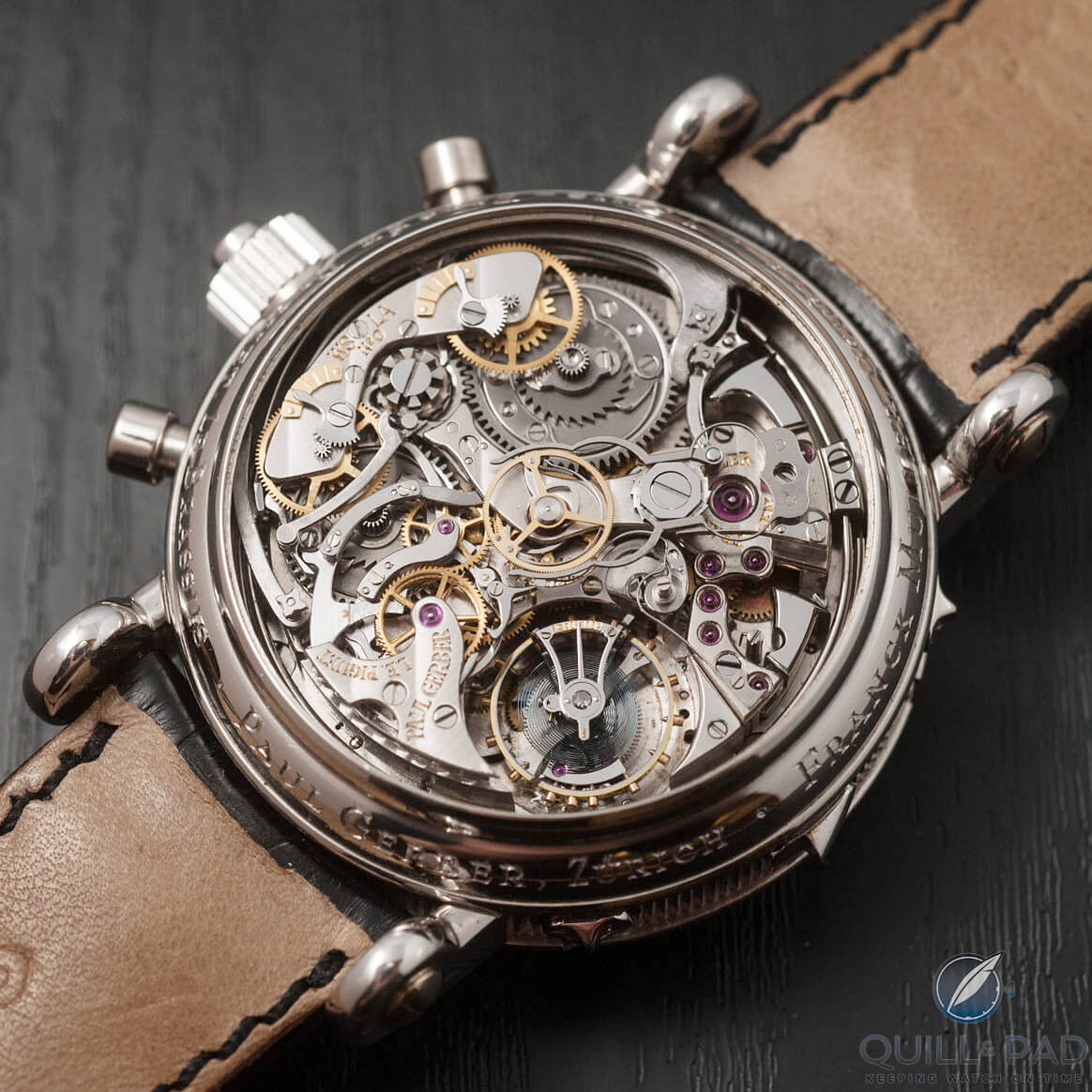
A masterpiece is completed: movement view of the Superbia Humanitatis (photo courtesy Dr. Magnus Bosse)
When contemplating a suitable name for this masterpiece, several criteria were set: the name should be catchy, it should appeal to a global audience, and it should convey the message of this watch.
In the end, the Latin name Superbia Humanitatis (“the pride of mankind”) was chosen.
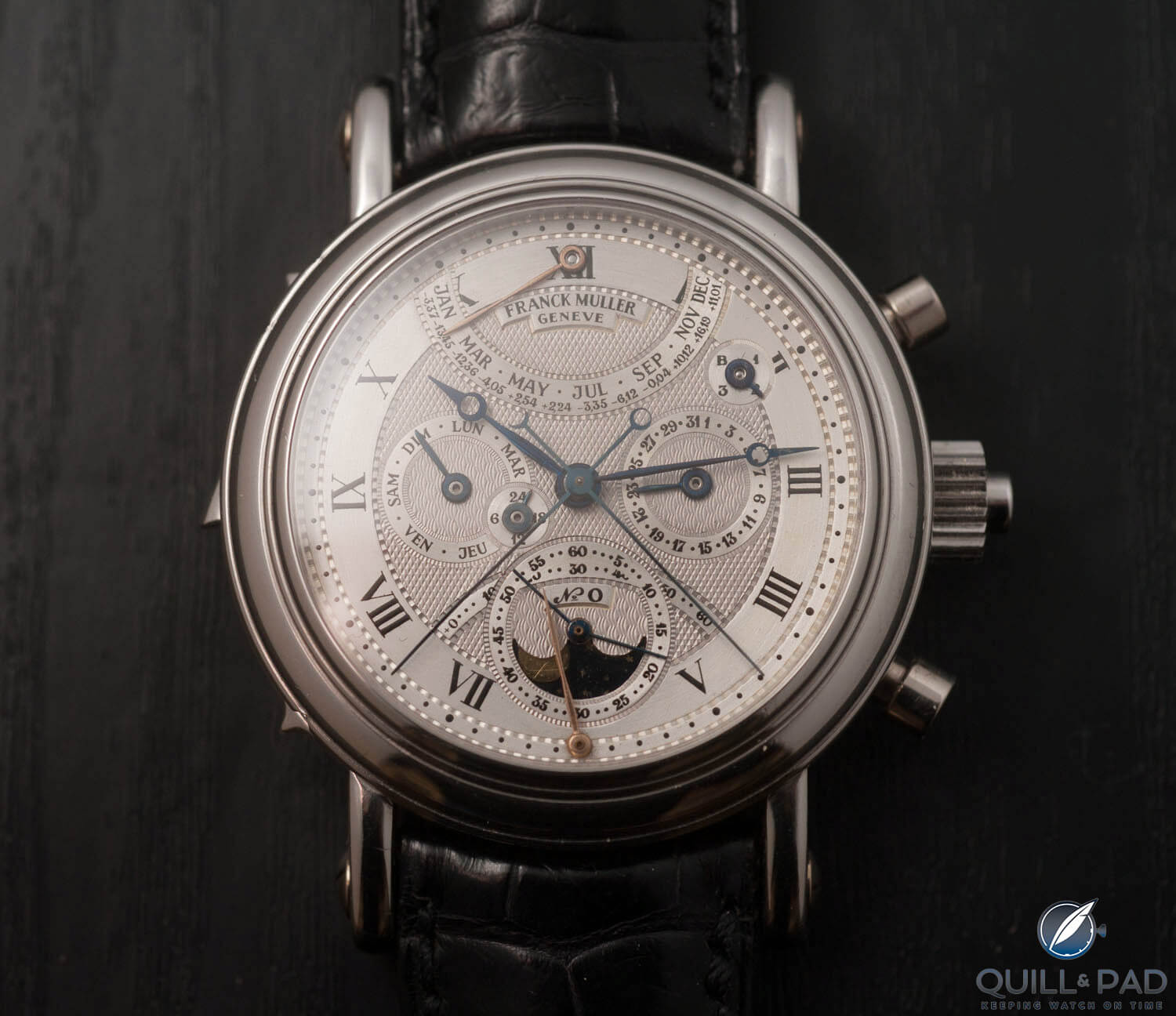
Superbia Humanitatis: the “pride of mankind”
Superbia Humanitatis captures the objective of the watch completely: while overtly confident, it’s confident with reason: Graf considers this watch not only as an end in itself but as a stimulus for young watchmakers to take up challenges and create their own extraordinary timepieces.
Quick Facts Superbia Humanitatis (formerly known as Caliber 92, the Piguet/Muller/Gerber Grand Complication, and the Lord Arran)
Case: custom-made platinum case by Grandjean Sarl, 39 x 18.63 mm (original Franck Muller case 39 x 14.7 mm)
Dial: hand-guilloche
Movement: Louis-Elysée Piguet caliber from 1892, diameter 32 mm (including gong springs) and 28.3 mm (without gong springs); height 8 mm (original Piguet movement) and 13.4 mm (after final modifications); 18.000 vph/2.5 Hz frequency; twin spring barrels; base movement 491 components; after modifications by Franck Muller: 651; after final modifications by Paul Gerber: 1,116 components (including case)
Functions: hours, minutes, subsidiary seconds; minute repeater with silence function and large & small sonnerie; added to by Franck Muller: perpetual calendar with moon phase, equation of time indication, 24-hour hand, thermometer displayed by a retrograde hand; added to by Paul Gerber: one-minute flying tourbillon with diamond endstone, flyback split-seconds chronograph with jump-minute counter, power reserve indications for going and chiming trains
Dr. Magnus Bosse is a previous moderator at the watch collector community PuristSPro.com and co-founder at MING Watches.
* This article was first published on April 17, 2018 at The Ongoing Saga Of The ‘Superbia Humanitatis,’ The World’s Most Complicated Wristwatch By Louis-Elysée Piguet, Franck Muller, and Paul Gerber.
You might also enjoy:
Paul Gerber: Renaissance Man And Creator Of World’s Most Complicated Watch And Smallest Wooden Clock
The Watch That Changed My Life: The Jean Daniel Nicolas Two-Minute Tourbillon By Daniel Roth
Leave a Reply
Want to join the discussion?Feel free to contribute!





















































The Patek 5175 Headmaster Chime has more complications (20 vs this one’s 17, at my count) and more pieces (1,366 to this one’s 1116).
And the PP 5175 has second time zone and alarms function which are more useful and practical than the flyback split-seconds chronograph function imo.